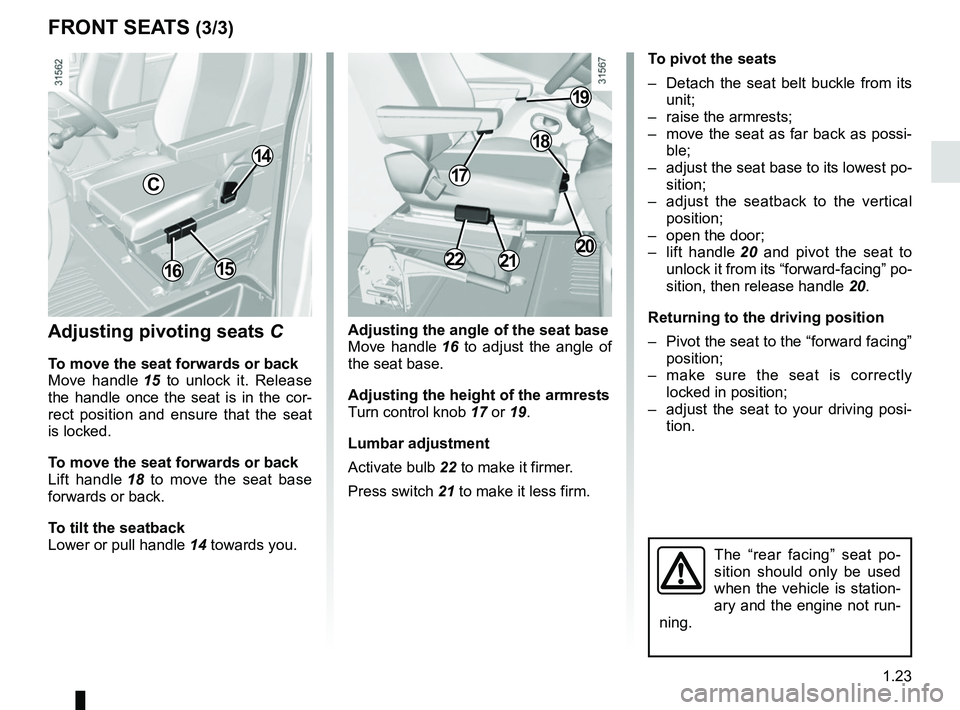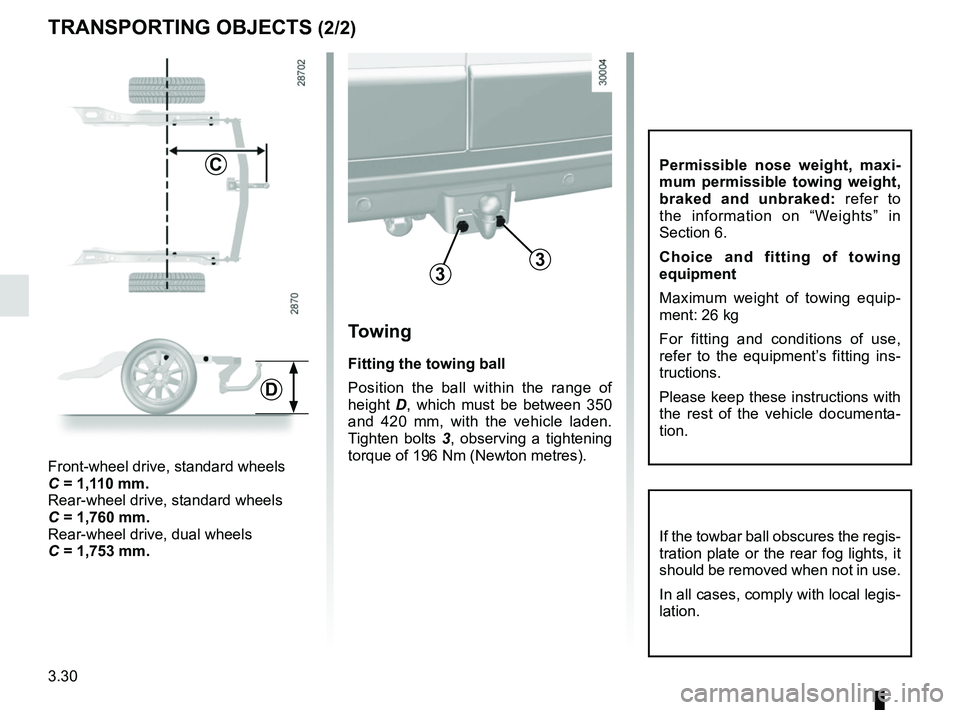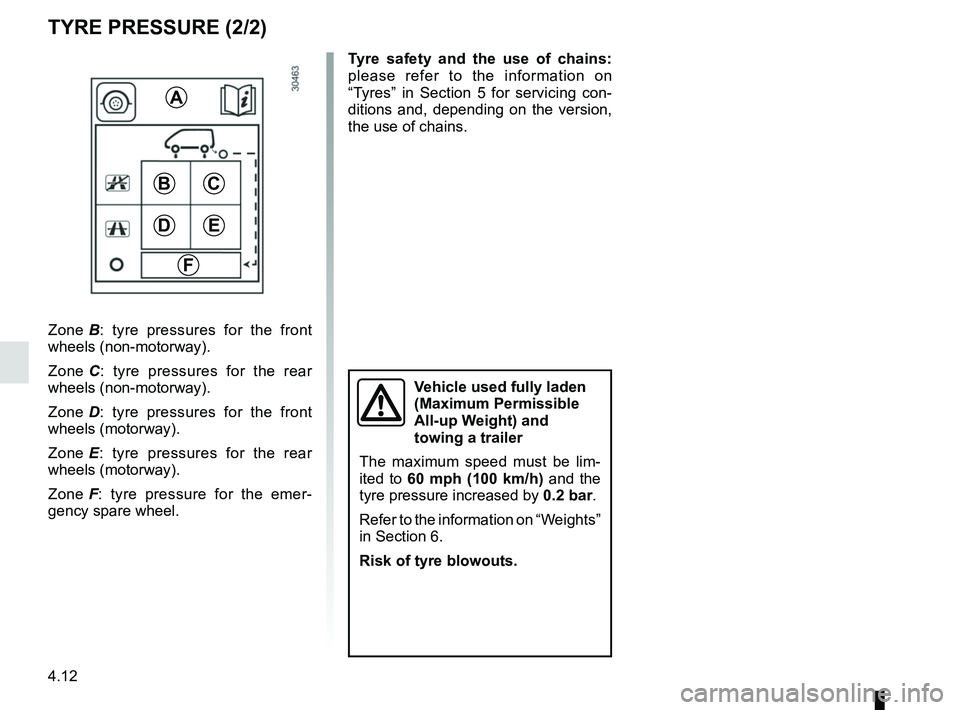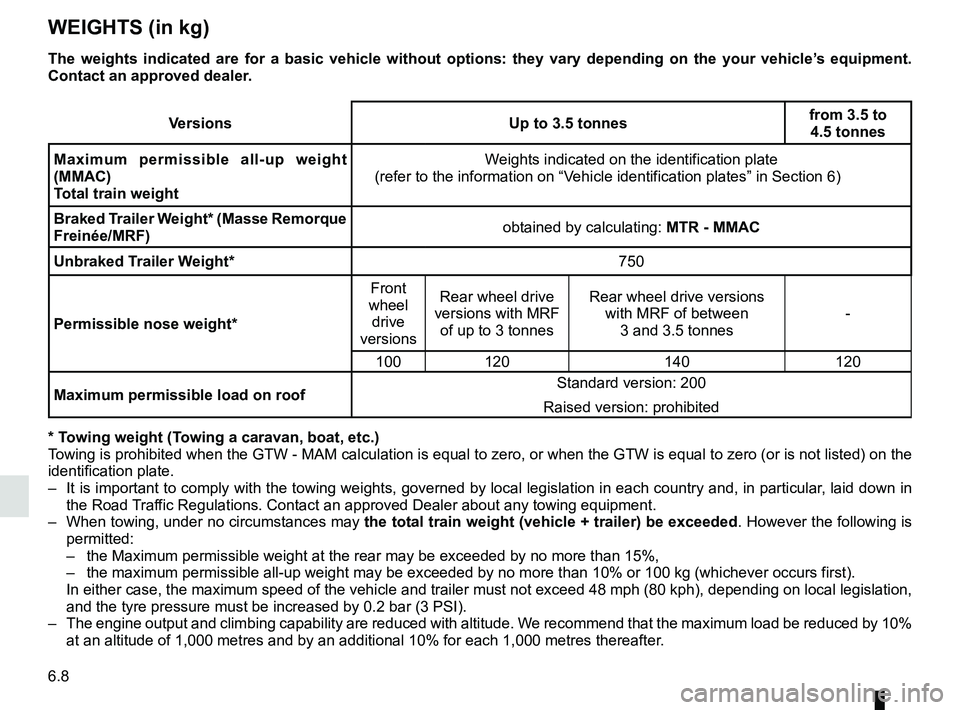2018 RENAULT MASTER tow bar
[x] Cancel search: tow barPage 28 of 290

1.22
FRONT SEATS (2/3)
Adjusting seat B with
suspension
To move forwards or backwards
Lift handle 11 to release. Release the
handle once the seat is in the correct
position and ensure that the seat is
locked.
To tilt the seatback
Lower or pull control 7 towards you.
To adjust the height of the seat base
Move control 9 to adjust the rear of the
seat base or control 10 to adjust the
front of the seat base.
6
7
910118
Lumbar adjustment
Activate bulb 12 to make it firmer.
Press switch 13 to make it less firm.
To adjust the seat suspension
Turn control knob 6 to the right to stiffen
the suspension and to the left to reduce
it.
1312
Heated seats(depending on the vehicle)
With the ignition on , press switch 8.
The integrated indicator comes on.
The system, which has a thermostat,
decides whether or not the heating is
needed.
B
Page 29 of 290

1.23
FRONT SEATS (3/3)
Adjusting pivoting seats C
To move the seat forwards or back
Move handle 15 to unlock it. Release
the handle once the seat is in the cor-
rect position and ensure that the seat
is locked.
To move the seat forwards or back
Lift handle 18 to move the seat base
forwards or back.
To tilt the seatback
Lower or pull handle 14 towards you.
The “rear facing” seat po-
sition should only be used
when the vehicle is station-
ary and the engine not run-
ning.
Adjusting the angle of the seat base
Move handle 16 to adjust the angle of
the seat base.
Adjusting the height of the armrests
Turn control knob 17 or 19.
Lumbar adjustment
Activate bulb 22 to make it firmer.
Press switch 21 to make it less firm.
To pivot the seats
– Detach the seat belt buckle from its unit;
– raise the armrests;
– move the seat as far back as possi- ble;
– adjust the seat base to its lowest po- sition;
– adjust the seatback to the vertical position;
– open the door;
– lift handle 20 and pivot the seat to
unlock it from its “forward-facing” po-
sition, then release handle 20.
Returning to the driving position
– Pivot the seat to the “forward facing” position;
– make sure the seat is correctly locked in position;
– adjust the seat to your driving posi- tion.
14
15162122
18
17
19
20
C
Page 134 of 290

2.18
DRIVING CORRECTION DEVICES AND AIDS (3/8)
Emergency brake assist
This system supplements the ABS
and helps reduce vehicle stopping dis-
tances.
Operating principle
The system is for detecting an emer-
gency braking situation. In this case,
the braking assistance immediately de-
velops maximum power and may trig-
ger ABS regulation.
ABS braking is maintained as long as
the brake pedal is applied.
Hazard warning lights switching on
Depending on the vehicle, these may
light up in the event of sudden decel-
eration.
Operating faults
When the system detects an operat-
ing fault the message “CHECK ABS”
appears on the instrument panel along
with the
© warning light.
Consult an approved dealer.
Driver assistance with a
trailer
This system helps to maintain control
over the vehicle while using a trailer.
It detects shaking caused by towing a
trailer under certain driving conditions.
Operating conditions
– The towbar must be approved by an authorised dealer;
– the harness must be approved by an authorised dealer;
– the towbar must be connected to the vehicle.
Operating principle
The function stabilises the vehicle by:
– asymmetric braking of the front wheels to reduce shaking caused by
the trailer;
– braking of all four wheels and limita- tion on engine torque to reduce the
vehicle speed until the shaking has
stopped.
Warning light
flashes on the in-
strument panel to inform the driver.
Active emergency braking
Using the sensor 1, the system calcu-
lates the distance separating the vehi-
cle from the one in front and alerts the
driver if there is a risk of a front-end col-
lision. The driver can then brake the ve-
hicle to limit the damage arising from a
collision.
Note: Make sure that the sensor 1 is
not obscured (by dirt, mud, snow, etc.).
1
Page 196 of 290

3.30
TRANSPORTING OBJECTS (2/2)
Towing
Fitting the towing ball
Position the ball within the range of
height D, which must be between 350
and 420 mm, with the vehicle laden.
Tighten bolts 3, observing a tightening
torque of 196 Nm (Newton metres).
33
C
Front-wheel drive, standard wheels
C = 1,110 mm.
Rear-wheel drive, standard wheels
C = 1,760 mm.
Rear-wheel drive, dual wheels
C = 1,753 mm.
D
If the towbar ball obscures the regis-
tration plate or the rear fog lights, it
should be removed when not in use.
In all cases, comply with local legis-
lation.
Permissible nose weight, maxi-
mum permissible towing weight,
braked and unbraked: refer to
the information on “Weights” in
Section 6.
Choice and fitting of towing
equipment
Maximum weight of towing equip-
ment: 26 kg
For fitting and conditions of use,
refer to the equipment’s fitting ins-
tructions.
Please keep these instructions with
the rest of the vehicle documenta-
tion.
Page 208 of 290

4.12
BC
ED
F
A
Zone B: tyre pressures for the front
wheels (non-motorway).
Zone C : tyre pressures for the rear
wheels (non-motorway).
Zone D : tyre pressures for the front
wheels (motorway).
Zone E : tyre pressures for the rear
wheels (motorway).
Zone F : tyre pressure for the emer-
gency spare wheel.
TYRE PRESSURE (2/2)
Tyre safety and the use of chains:
please refer to the information on
“Tyres” in Section 5 for servicing con-
ditions and, depending on the version,
the use of chains.
Vehicle used fully laden
(Maximum Permissible
All-up Weight) and
towing a trailer
The maximum speed must be lim-
ited to 60 mph (100 km/h) and the
tyre pressure increased by 0.2 bar.
Refer to the information on “Weights”
in Section 6.
Risk of tyre blowouts.
Page 252 of 290

5.38
TOWING: breakdown (1/2)
The steering wheel must be un-
locked and the ignition key must be
in position M (ignition on) to provide
brake lights and hazard warning
lights on the towed vehicle. At night
the vehicle must have its lights on.
Unhitch the trailer, etc., if one is
being towed.
You must observe the towing regu-
lations which apply in the country in
which you are driving: do not exceed
the towing weight for your vehicle.
Contact an approved dealer.
– Use a rigid towing bar.
If a rope or cable is used
(where the law allows this),
the vehicle being towed
must be able to brake.
– A vehicle must not be towed if it is not fit to be driven.
– Avoid accelerating or braking suddenly when towing, as this
may result in damage being
caused to the vehicle.
– When towing a vehicle, it is ad- visable not to exceed 15 mph
(25 km/h).
When the engine is
stopped, steering and brak-
ing assistance are not op-
erational.
Do not remove the key from
the ignition when the vehi-
cle is being towed.
Towing a vehicle with a
sequential gearbox
If the gearbox is stuck in a gear:
– switch on the ignition;
– select neutral with the brake pedal depressed;
– check that the gearbox is in neutral (by pushing the vehicle for example).
If you cannot find neutral you must tow
the vehicle with the front wheels raised.
The vehicle should always be towed
with the ignition switched off.
Page 268 of 290

6.8
WEIGHTS (in kg)
VersionsUp to 3.5 tonnesfrom 3.5 to
4.5 tonnes
Maximum permissible all-up weight
(MMAC)
Total train weight Weights indicated on the identification plate
(refer to the information on “Vehicle identification plates” in Section 6)
Braked Trailer Weight* (Masse Remorque
Freinée/MRF) obtained by calculating:
MTR - MMAC
Unbraked Trailer Weight* 750
Permissible nose weight* Front
wheel drive
versions Rear wheel drive
versions with MRF of up to 3 tonnes Rear wheel drive versions
with MRF of between 3 and 3.5 tonnes -
100 120 140120
Maximum permissible load on roof Standard version: 200
Raised version: prohibited
* Towing weight (Towing a caravan, boat, etc.)
Towing is prohibited when the GTW - MAM calculation is equal to zero, or \
when the GTW is equal to zero (or is not listed) on th e
identification plate.
– It is important to comply with the towing weights, governed by local leg\
islation in each country and, in particular, laid down in the Road Traffic Regulations. Contact an approved Dealer about any towing equipment.
– When towing, under no circumstances may the total train weight (vehicle + trailer) be exceeded . However the following is
permitted:
– the Maximum permissible weight at the rear may be exceeded by no more th\
an 15%,
– the maximum permissible all-up weight may be exceeded by no more than 10\
% or 100 kg (whichever occurs first).
In either case, the maximum speed of the vehicle and trailer must not ex\
ceed 48 mph (80 kph), depending on local legislation, and the tyre pressure must be increased by 0.2 bar (3 PSI).
– The engine output and climbing capability are reduced with altitude. We recommend that the maximum load be reduced by 10% at an altitude of 1,000 metres and by an additional 10% for each 1,000 m\
etres thereafter.
The weights indicated are for a basic vehicle without options: they vary\
depending on the your vehicle’s equipment.
Contact an approved dealer.